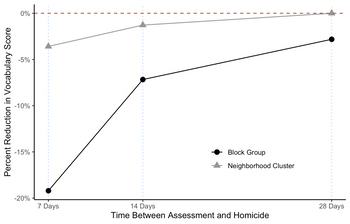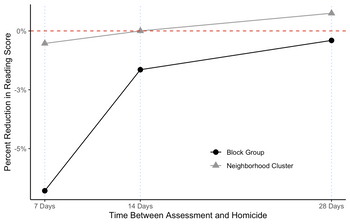This blog is a part of our new series, "Perspectives in Crime". We'll be exploring leading academic studies that touch on crime data.
In addition to bodily harm and loss of life, violent crime brings about collateral damage as it spreads fear, trauma, and uncertainty across a community. Social scientists have long been concerned with evaluating and understanding these additional costs and the extent of violence’s reach into a community. Many researchers have turned towards educational data to determine the impact on children who are exposed to community level violence. The trauma of violent crime can affect a child’s wellbeing with socio-emotional, physiological, and cognitive responses. All of these can manifest in weakened academic performance and have real consequences for educational attainment and outcomes.
How homicide exposure affects children's cognitive performance
In a study published in the Proceedings of the National Academy of Sciences, Patrick Sharkey (2010) estimated the acute effects of child exposure to homicide on cognitive performance across various standardized tests. Sharkey linked cognitive performance data on children from 5 to 17 years of age from the Project on Human Development in Chicago Neighborhoods (PHDCN) to 6,041 geocoded homicides reported by the Chicago Police Department. Sharkey’s analytic strategy exploited the statistical independence of the timing of homicides vis-à-vis the timing of cognitive assessments. Because the timing of a homicide event is random with respect to the timing of cognitive testing, Sharkey’s reported results may be interpreted as causal as opposed to correlational in nature.
This study did not track whether individual students had witnessed a violent crime, or were connected to perpetrator or victim, but took for granted that severe criminal violence on the neighborhood level would reach a child’s awareness, even if only via changed family and community behavior.
Two assessments were available to Sharkey in the PHDCN data. One test measured a child’s command of vocabulary — the Wechsler Intelligence Scale for Children— and the other test captured the reading comprehension skills of a child — the Wide Range Achievement Test. Both tests have been validated and extensively used in educational settings.
What Sharkey discovered was striking and disheartening. Test scores among African American children decreased substantially if they experienced a homicide event within seven days of test taking. Intriguingly, the test performance effects of witnessing violence dissipated with time, perhaps speaking to the underlying resilience of children in neighborhoods routinely visited by violence. Sharkey also showed that the cognitive effects of exposure to violence in children were higher among children most proximate to a homicide event. Figures 1 and 2 summarize the results.
Impact of homicide exposure on vocabulary and reading comprehension
In Figure 1 we see the impact of homicide events on child performance in the vocabulary test. The circles in blue show the homicide effect among children experiencing violence on their residential block. The triangles in red show the vocabulary impact among children exposed to violence in their broader neighborhood cluster. (A neighborhood cluster is a about five times the size of a residential block.)
Among African American children tested within seven days of a homicide event occurring in their block of residence, we observe an almost 20% reduction in vocabulary performance. At 14 days from a homicide event, the negative performance impact is around 6%. At 28 days from a homicide event, the estimated effect diminishes to around 2%. Across all timing measures of 7, 14 and 28 days, the negative cognitive effect of a homicide event is lower in neighborhood clusters, implying that homicide events are more impactful the closer they occur to a child’s residence.

In Figure 2, we see homicide effects on reading comprehension tests. While homicide effects are smaller in magnitude when it comes to reading comprehension, they operate similarly in terms of being stronger the closer they are to child in time and space.

What Sharkey’s study shows is that the willful killing of a person echoes through a community, imprinting the psyche of children and undermining the realization of their potential in school. Though Sharkey’s study captures a short-term effect of violent crime, his findings speculate that students in communities regularly suffering from local acts of violence regularly experience these shocks. Sharkey states “according to these same calculations, African-American sample members living in the city’s most violent neighborhoods spend at least one quarter of the year, or roughly 1 week out of every month, functioning at a low level because of local homicides.” This regular impairment can only have detrimental impacts on educational outcomes and attainment.
While many contemporary interventions are designed to provide treatment and counseling to students directly exposed to violence, these findings suggest broader recognition of the impacts violence can have on children living in a neighborhood struck by violence, whether or not they are directly connected to the incident.
Curious about crime risk in your area? Check out the Pinkerton Crime Index to learn more.
Sources:
Sharkey, P. (2010). The acute effect of local homicides on children’s cognitive performance. Proceedings of the National Academy of Sciences. 107(26): 11733-11738.




